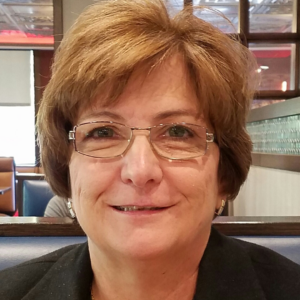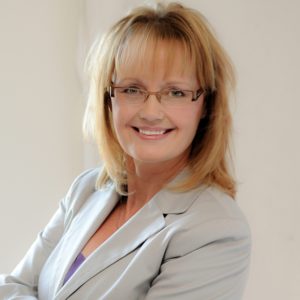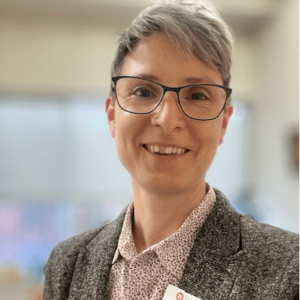Security Policies and Practices to Ensure Safety for Memory Care Residents
Security is always a concern in senior care settings, but memory care settings face some additional security concerns. From addressing factors like elopement and social connections to preparing and educating staff on emergency procedures, providing security in memory care settings requires a comprehensive approach.
Unique Security Concerns in Memory Care

Joan DiPaola, senior dementia care specialist at CareOne Paramus, Harmony Village
Joan DiPaola, senior dementia care specialist at CareOne Paramus, Harmony Village and certified dementia instructor, explains that security concerns in memory care consist of both intrinsic and extrinsic factors. “Extrinsic factors are environmental concerns,” she says. These include points like whether the building is safe and secure, how to ensure there is no resident elopement, safety measures to help minimize falls, and more.
Intrinsic factors, on the other hand, are emotional concerns. “Are the patients bored? Are we providing the right level of care and activities at every stage of dementia to promote engagement and participation? Are they socializing with peers and family members and spending time outdoors?” poses DiPaola. “All these considerations are crucial to ensuring patients are safe and are cared for with dignity.”
The Greatest Memory Care Security Concerns
The greatest challenge to memory care security, according to DiPaola, is boredom. “When dementia patients are bored, they can become agitated and are more likely to elope from the facility,” she says. “So, it’s imperative to ensure the patients are stimulated and receiving the right level of care at every stage of their dementia.”
Additionally, social connection is also very important. “When dementia patients are living at home, they’re usually isolated and may have one home care nurse who may not have experience in caring for a person with dementia. In a facility, patients can interact with their peers, nurses and visitors, which can help stunt memory loss development,” DiPaola explains. “In addition, having staff who are well-trained in memory and dementia care and treatment is imperative.”
Security Policies and Practices to Ensure Resident Safety
DiPaola notes that there are many best practices for security in memory care. These include putting keypads on all exit doors, never leaving doors propped open, and having visitors leave their car keys at the front desk during visits. Additionally, understanding the level of cognition of each patient with regular testing to evaluate the disease progression and potential causes is important. Staff should also be trained on emergency procedures.
But beyond specific security policies, DiPaola notes the importance of using positive language. “At CareOne Paramus Harmony Village, we don’t call ourselves a memory care lockdown facility – instead, we are a secure facility who will keep loved ones safe in a secure environment,” she says. “We’re also made up of six unique neighborhoods, which are what we call our patient units. We call them neighborhoods instead of wards because we want to deinstitutionalize memory care.”
How Facility Design Affects Resident Safety
Ensuring resident safety starts with strategic facility design. DiPaola recommends creating facilities with lots of outdoor space, including pathways wide enough for wheelchairs and smooth enough to prevent falls. “At CareOne, we have raised garden beds so they are easier to see for patients who are losing their peripheral vision and that can stimulate them while walking.”
It’s also important to consider color in facility design. “White toilets in a white bathroom can confuse dementia patients whose depth perception is off. We always recommend family members or caregivers purchase a colored toilet seat for their loved one so they can better distinguish where the toilet is. The same goes for dishware. White plates are discouraged since many foods like rice or chicken can blend in and be harder for a patient to identify when eating,” says DiPaola.
Positioning beds so they are low to the ground can help prevent falls and injuries. Mats on the floor can act as a cushion if falls do happen.
“Most people who are suffering from Alzheimer’s or dementia need to feel safe and secure but the facility should also be home-like,” DiPaola notes. To accomplish this home-like feel, residents should have the freedom of mobility to maintain a feeling of independence. Creating game rooms, music programs, and outdoor space can give residents some alone time when they want it. “You don’t want lights that are too harsh or alarms that could trigger agitation, aggression or a fall,” says DiPaola. “Additional decorative enhancements to promote homeliness and stimulation are colorful artwork with plexiglass, clocks, radios, motion detection lights, and colorful monster tape on the floors to guide patients to the bathroom. Creating a well-lived environment for our patients will eliminate many risks and improve quality of life.”
How to Use Technology for Memory Care Security
Finally, evolving technology means that memory care programs have access to a wide range of tools that can enhance security. DiPaola notes that technology is an important part of ensuring patient safety. This can include the use of day and night clocks and automated and motion-detection lights that can guide residents to the bathroom at night. “We also have automatic shut offs, central control for thermostats to ensure patients are always comfortable, sensors in hearing aids to help locate them via a phone if they ever get lost and automated pill dispensers that are connected to the Cloud to help distribute medication,” she says.”
By using a variety of tools and approaches, memory care facilities can address both extrinsic and intrinsic factors contributing to security concerns. This comprehensive approach can enhance both resident safety and the overall quality of care the facility provides.

Paige Cerulli is a contributing writer to i Advance Senior Care.
Related Articles
Topics: Activities , Alzheimer's/Dementia , Featured Articles , Information Technology , Resident Care , Technology & IT











